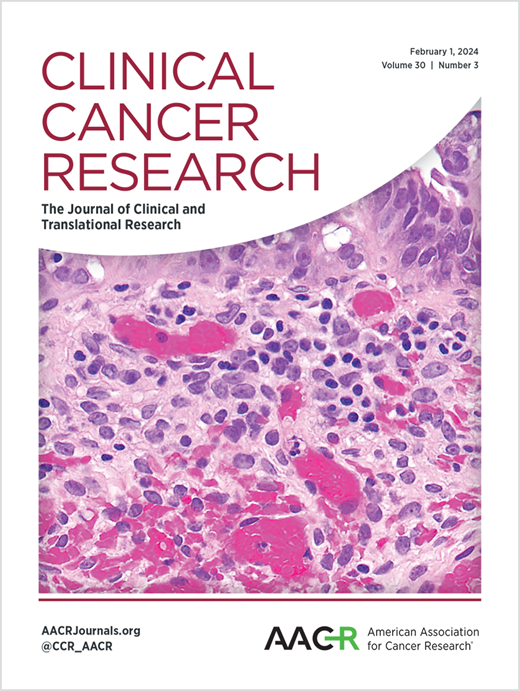GANNET53 Part II: A European Phase I/II Trial of the HSP90 inhibitor Ganetespib in high-grade Platinum-Resistant Ovarian Cancer - A Study of the GANNET53 consortium
IF 10.2
1区 医学
Q1 ONCOLOGY
引用次数: 0
Abstract
Purpose: Mutant TP53 stabilized by heat shock protein 90 (HSP90) is a novel target in oncology. The open-label randomized phase II GANNET53 trial is the first to evaluate the HSP90 inhibitor Ganetespib (G) with Paclitaxel (P) in platinum-resistant epithelial ovarian cancer (EUDRACT 2013-003868-31; EU FP7 #602602). Patients and Methods: Patients were randomized 2:1 to receive G+P or P alone until progression. Primary endpoints were progression-free survival (PFS) and PFS rate at six months. Exploratory endpoints were biomarkers based on p53 and HSP90. Results: A total of 133 patients were enrolled. Median PFS was 3.5 (G+P) and 5.3 months (P) (HR 1.3, 95% CI: 0.897-1.895, P = 0.16), PFS rates at six months were 22% (G+P) and 33% (P). No significant differences were found in overall survival, objective response rate and post progression PFS between arms. Most frequent adverse events (AEs) were diarrhea (79% vs. 26%), anemia (46% vs. 51%), nausea (41% vs. 40%), and peripheral neuropathy (36% vs. 47%). Serious AEs were more common in G+P (39.5% vs. 23.3%). Gastrointestinal perforation was a new safety finding. Despite of a high TP53 mutation frequency, HSP90-p53 complexes were detected in only 39.6% of the cases and were also detected stably during treatment. In-vitro, no synergistic effects of G+P were observed, and mutp53 depletion did not sensitize ovarian cancer cells to treatment. Conclusions: Although no major safety findings were observed, G+P did not lead to survival benefit. Our companion diagnostic programme confirmed that G+P do not favorably cooperate in killing ovarian cancer cells.GANNET53第二部分:HSP90抑制剂Ganetespib治疗高级别铂耐药卵巢癌的欧洲I/II期临床试验- GANNET53联合研究
目的:热休克蛋白90 (HSP90)稳定突变体TP53是肿瘤治疗的新靶点。开放标签随机II期GANNET53试验是首个评估HSP90抑制剂Ganetespib (G)联合紫杉醇(P)治疗铂耐药上皮性卵巢癌的试验(EUDRACT 2013-003868-31;欧盟fp7 #602602)。患者和方法:患者按2:1随机分组,分别接受G+P或单独接受P治疗直至病情进展。主要终点是6个月时的无进展生存期(PFS)和PFS率。探索性终点是基于p53和HSP90的生物标志物。结果:共纳入133例患者。中位PFS分别为3.5 (G+P)和5.3个月(P) (HR 1.3, 95% CI: 0.897-1.895, P = 0.16), 6个月PFS率分别为22% (G+P)和33% (P)。两组患者的总生存率、客观有效率和进展后PFS均无显著差异。最常见的不良事件(ae)是腹泻(79%对26%)、贫血(46%对51%)、恶心(41%对40%)和周围神经病变(36%对47%)。严重ae在G+P组更为常见(39.5%比23.3%)。胃肠道穿孔是一项新的安全性发现。尽管TP53突变频率很高,但仅在39.6%的病例中检测到HSP90-p53复合物,并且在治疗期间检测稳定。在体外,没有观察到G+P的协同作用,mutp53的缺失不会使卵巢癌细胞对治疗敏感。结论:虽然没有观察到重大的安全性发现,但G+P并没有导致生存获益。我们的伴随诊断程序证实G+P在杀死卵巢癌细胞方面没有良好的合作。
本文章由计算机程序翻译,如有差异,请以英文原文为准。
求助全文
约1分钟内获得全文
求助全文
来源期刊

Clinical Cancer Research
医学-肿瘤学
CiteScore
20.10
自引率
1.70%
发文量
1207
审稿时长
2.1 months
期刊介绍:
Clinical Cancer Research is a journal focusing on groundbreaking research in cancer, specifically in the areas where the laboratory and the clinic intersect. Our primary interest lies in clinical trials that investigate novel treatments, accompanied by research on pharmacology, molecular alterations, and biomarkers that can predict response or resistance to these treatments. Furthermore, we prioritize laboratory and animal studies that explore new drugs and targeted agents with the potential to advance to clinical trials. We also encourage research on targetable mechanisms of cancer development, progression, and metastasis.
 求助内容:
求助内容: 应助结果提醒方式:
应助结果提醒方式:


